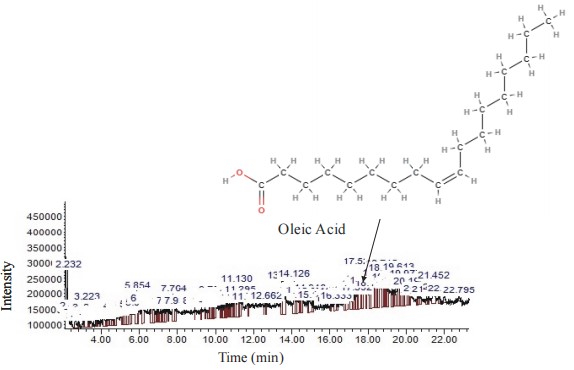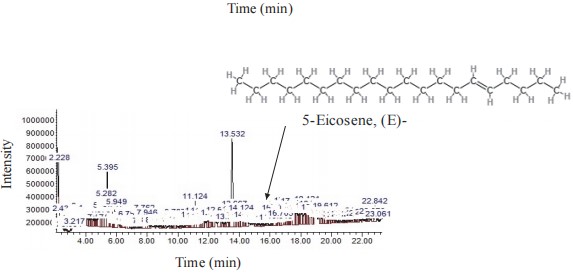Characterization of Bioactive Compounds in Cereal-Based Porridge Enriched with Cirina forda
Background and Objective: Cereal gruel is a staple food mostly found among low-income earners in underdeveloped and developing countries. Fortifying this food may help solve the problem of malnutrition among consumers. This study was carried out to examine the antioxidant and phytochemical properties of porridge from yellow maize and malted sorghum enriched with Cirina forda. Materials and Methods: Maize and sorghum grains, and Cirina forda were sorted, washed, fermented for 72 hrs, processed into slurry, and ultimately converted into flour, respectively. The obtained flours were blended in ratios: 50:30:20; 60:30:20; 50:20:30; and 100:0:0 for fermented maize: Malted sorghum: Cirina forda flour, respectively. The resultant flour mixtures were processed into porridge (enriched). The porridge was evaluated for bioactive compounds. Results: The highest antioxidant activities (DPPH: 217.03 μmol TEAC/100 g, FRAP: 43.3 mmol Fe² /100 g, TBARS: 35.56%) were observed in sample 50FYM+20MS+30CF, while the control showed the lowest values (DPPH: 146.10 μmol TEAC/100 g, FRAP: 20.18 mmol Fe² /100 g, TBARS: 13.25%). Oxalate and tannin contents were lowest in 50FYM+20MS+30CF; however, oxalate peaked in the control, and tannin in 60FYM+20MS+20CF. The highest phytate content (2.32 mg/100 g) occurred in 60FYM+20MS+20CF, with the control showing the lowest (2.20 mg/100 g). Total phenolics were highest in 60FYM+20MS+20CF (318.28 mg GAE/100 g) and lowest in 50FYM+30MS+20CF. Total flavonoids peaked in 50FYM+20MS+30CF (189.31 mg RE/100 g) and were lowest in 60FYM+20MS+20CF (90.10 mg RE/100 g). Conclusion: The combination of maize, sorghum, and Cirina forda in the porridge significantly (p<0.05) enhanced its antioxidant properties, as indicated by the higher DPPH and FRAP values compared to the control (100% maize porridge). This suggests why the porridge may have stronger antioxidant activity, which is beneficial to human health. The phytochemical property also provided valuable insights into the phytochemical composition of the cereal-based porridge formulations, shedding light on their potential health implications.
INTRODUCTION
Cereal gruels prepared from fermented maize (yellow and white) and sorghum seeds are the forms in which cereals are popularly consumed in tropical Africa, mostly as weaning food for children. Gruel is a type of food that has been consumed for centuries in many different cultures. Cereal gruel is a type of porridge made by cooking ground cereal grains in water or milk until they thicken into a smooth, creamy consistency. It is a simple, usually inexpensive dish that is made by boiling grains or cereal in water or milk until it becomes a thick, porridge-like consistency. Gruel can be made from a variety of grains, such as oats, cornmeal, rice, or barley1,2.
Historically, gruel has been a staple food for many people, especially those who were poor or lived in areas where food was scarce. It was often eaten for breakfast, and sometimes served as a main meal, either on its own or with additional ingredients such as fruits, nuts, or meat. Gruel was also commonly served in institutions such as prisons or workhouses2,3.
In some cultures, gruel is still a popular dish. For example, in parts of Africa and Asia, it is made from maize or millet and served as a breakfast or snack food. In some places, it is also used as a baby food, due to its simple and easily digestible nature2,3. While gruel is often associated with poverty or hardship, it can also be a comforting and nutritious meal. Depending on the ingredients used, it can be a good source of carbohydrates, fiber, and protein. It can also be seasoned with spices or sweeteners to add flavor and variety.
Yellow maize, also known as corn, is a popular cereal grain that is widely consumed around the world. Yellow maize is a rich source of carbohydrates, dietary fiber, and several important vitamins and minerals. It is particularly high in thiamin (vitamin B1), folate, and vitamin C. Yellow maize also contains small amounts of protein and fat. The limiting amino acid in yellow maize is lysine. This means that it contains lower levels of lysine compared to other essential amino acids that are necessary for human health1.
Yellow maize is a good source of energy and essential nutrients, and it may have several health benefits. For example, the dietary fiber in maize may help to reduce cholesterol levels and improve digestive health. Yellow maize is also rich in antioxidants, which may help to prevent chronic diseases such as cancer and cardiovascular disease. Additionally, yellow maize has anti-inflammatory effects that could benefit individuals with conditions such as arthritis4,5.
Malted sorghum is a cereal grain that has been germinated and dried. It is a good source of nutrition, containing high levels of carbohydrates, fiber, and protein. However, it is limited in certain amino acids, particularly lysine. Despite this limitation, malted sorghum has several health benefits. It is gluten-free, making it a good option for people with celiac disease or gluten sensitivities. It also has a low glycemic index, meaning it does not cause a rapid spike in blood sugar levels, making it a suitable option for people with diabetes. Malted sorghum is rich in antioxidants, which help protect against chronic diseases such as cancer, heart disease, and diabetes. It is also a good source of minerals, including iron, zinc, and magnesium6,7.
To increase the nutritional value of cereal-based porridge, it can be combined with legumes, animal, animal products, or edible insects that are rich in lysine. This helps balance the amino acid profile and create a complete protein source6,7.
Cereals are an essential source of dietary nutrients and play a significant role in human nutrition. However, their nutritional value is limited due to the lack of essential micronutrients such as vitamins, minerals, and bioactive compounds. One way to improve the quality of cereal-based foods is by incorporating natural sources of bioactive compounds.
Bioactive compounds play a vital role in preventing chronic diseases and promoting overall health. However, the human body cannot produce these essential substances, and they must be obtained through the diet. Cereals are a staple food in many countries, and their consumption is increasing globally.
However, the lack of essential micronutrients in cereals is a significant concern, particularly in developing countries where malnutrition is prevalent. Cirina forda is a natural source of bioactive compounds, making it an ideal candidate for enhancing the nutritional value of cereal-based foods. By enriching cereal-based porridge with Cirina forda, it can provide a nutrient-dense and affordable food option that can improve the overall health of individuals, particularly in low-income communities.
The primary objective of this study is to investigate the bioactive compounds present in porridge made from yellow maize and malted sorghum enriched with Cirina forda. Specifically, it aims to identify and quantify the bioactive compounds in the enriched blends and evaluate their potential health benefits.
MATERIALS AND METHODS
Study area: This study was conducted between March and September, 2023 at Ikole-Ekiti, Ekiti State, Nigeria.
Material: The dried Cirina forda was obtained from Ado-Ekiti, while yellow maize and sorghum grains were purchased from the central market in Ikole, Ekiti State, Nigeria.
Preparation of fermented maize flour: Fermented cornmeal was produced8, with slight modification. The maize grains were carefully washed and sifted to remove any remaining grit and dust. It will then be steeped in water (1:10, w/v) for 72 hrs while the water is changed daily. Thereafter, grains were removed, washed, and drained. The drained grains were wet-milled using an attrition mill, sieved using muslin cloth, and allowed to settle for 3 hrs. The supernatant was discarded, while the residue was dried in an oven at 55°C for 6 hrs. The product obtained was pulverized and passed through an aperture with a sieve size of 212 μ and was kept until required.
Preparation of malted sorghum flour: The old technique9 was used to make malted sorghum flour, with a small adjustment. The sorghum grains were sorted to remove foreign materials, cleaned, steeped in water for 18 hrs, and then drained. The dried grains were spread out on a jute bag and allowed to germinate for 72 hrs while being maintained in a dark cabinet at room temperature (30±0.5°C). The germinated grains were washed and dried for 48 hrs in a hot air oven at 50°C. It was cooled and massaged between palms to remove sprouts. The resultant was willowed and milled into powder. The malted sorghum flour was passed through a sieve with an aperture of 212 μ and was kept until required.
Preparation of Cirina forda flour: The stones and other found dirt were removed from the dried pale emperor larvae, and any dust that had adhered to them was washed away with potable water. The cleaned pale emperor larvae were dried in a hot air oven at 50°C for 8 hrs. The dried Cirina forda was milled to a fine powder and stored in a polythene bag.
Sample formulation: The various porridge blends were prepared as shown in Table 1 and homogenized using a Kenwood grinder, packed and sealed in a low-density polyethylene bag kept at ambient temperature until required for analysis.
Characterization of bioactive compounds in flakes
Identification and quantification of bioactive compounds: The bioactive compounds present in the samples was identified and quantified using Gas Chromatography Mass Spectrophotometry (GC-MS) (Agilent 19091S-933HP-1MS, US) with a 30 m 0.25 mm capillary column, 0.25 m film thickness constructed of 95% Dimethyl Polysiloxane, helium as a gas carrier, and temperature range of -60 to 325/350°C. The samples were exposed to dichloromethane and were cleaned through an SPE C18 cartridge (DCM). The identification of the bioactive compounds was done through the automated library database of the National Institute of Standards and Technology, and the amount of each bioactive compound was calculated using the average peak area to the total area ratio10.
| Table 1: | Formulation of cereal-based porridge enriched with Cirina forda | |||
| Expt. No. | Fermented yellow maize (g) | Malted sorghum (g) | Cirina forda (g) |
| 1 | 50 | 30 | 20 |
| 2 | 60 | 20 | 20 |
| 3 | 50 | 20 | 30 |
| Control | 100 | - | - |
Identification of biological activities of bioactive compounds: The biological activities of the identified bioactive compounds were computed through Duke’s Phytochemical and Ethnobotanical databases11.
Statistical analysis: All analyses were carried out in triplicate. Means differences were evaluated at a 5% significance level using the Duncan’s Test of SPSS version 17.
RESULTS AND DISCUSSION
Bioactive compound profile of cereal-based porridge enriched with C. forda: The bio-compounds identified in the cereal-based porridge are presented Table 2. First and foremost, it is evident that the enrichment of the porridge with C. forda led to an increase in the concentration of various bioactive compounds compared to the control sample (100% fermented yellow maize). This was particularly notable in the “50FYM+30MS+20CF” and “60FYM+20MS+20CF” samples, where the total bioactive compound content was substantially higher than in the control. This suggested that the inclusion of C. forda in the porridge formulation had a positive impact on the bioactive profile of the product.
Among the identified compounds, some stood out in terms of their potential bioactivity. For instance, cinnamic acid, methyl ester, found in all samples, is associated with anti-spasmodic, anti-malarial, pain-killing, diuretic, anti-hypertensive, and anti-asthma properties. Its increased presence in the enriched samples could indicate enhanced health benefits.
Additionally, 10-methyl-E-11-tridecen-1-ol propionate, methaqualone, and 3-(2-hydroxy-6-methylphenyl) -4(3H)-quinazolinone showed higher concentrations in the enriched samples, suggesting potential antimicrobial, depressant, muscle relaxant, anti-inflammatory, anti-malarial, anti-hypertensive, anti-convulsant, anti-histaminic, and anti-cancer activities12.
Oleic acid, known for its hypocholesterolemic and anti-cancer properties, also exhibited an increased concentration in the enriched porridge variants10,12,13. This could be particularly beneficial for individuals concerned with cholesterol levels and cancer prevention.
The results further showed that the total bioactive compound content was higher in the enriched samples, indicating their potential as functional foods with enhanced health-promoting properties. The chromatograms of the enriched porridge are shown Fig. 1(a-b). The figures represent the chromatograms illustrating the chemical profiles of cereal-based porridge under two different conditions. Oleic acid was found prominent in Fig. 1a with a retention time of 17.5 min. Oleic acid is a beneficial fatty acid known for its role in cardiovascular health, anti-inflammatory properties, and stability in food products14. The fact that it occurs in enriched porridge indicates increased nutritional quality. In Fig. 1b, the key compound identified is 5-Eicosene, having a retention time of 13.5 min. The 5-Eicosene is not a major nutrient but contributes to the aroma and volatile profile of the porridge. The peak intensity in Fig. 1a is higher compared to the control in Fig. 1b, which suggests a concentration of chemical compounds due to higher enrichment.
| Table 2: | Bioactive compounds profile of cereal-based porridge enriched with C. forda (g/100 g) | |||
| Identified compounds | Sample | |||||
| Formula | Name | 50FYM+30MS+20CF | 60FYM+20MS+20CF | 50FYM+20MS+30CF | Control (100% FYM) | Potential Bioactivity** |
| Cinnamic acid, m-(trimethylsiloxy)-, methyl ester | 0.74 | 0.82 | 0.95 | 0.67 | Anti-spasmodic, anti-malarial, pain-killer, diuretic-activities, anti-hypertensive, anti-asthma |
|
| C17H32O2 | 10-Methyl-E-11-tridecen-1-ol propionate | 6.17 | 6.85 | 7.96 | 5.55 | Antimicrobial |
| Methaqualone | 6.11 | 6.78 | 7.88 | 5.49 | Depressant, and muscle relaxant | |
| C19H36O | 12-Methyl-E,E-2,13-octadecadien-1-ol | 2.51 | 2.79 | 3.24 | 2.26 | Antihistaminic, anesthetic, anticonvulsant. |
| 3-(2-Hydroxy-6-methylphenyl)-4(3H) -quinazolinone |
3.14 | 3.49 | 4.05 | 2.82 | Anti-inflammatory, anti-malarial, anti-hypertensive, anti-convulsant, anti-histaminic, anti-cancer activities |
|
| Oleic Acid | 2.66 | 2.95 | 3.43 | - | Hypocholesterolemic , anti-cancer, anti-androgenic | |
| C25H52 | 2-Methyltetracosane | 1.77 | 1.96 | 2.28 | 1.59 | Anticancer, antioxidant |
| C20H40 | 5-Eicosene, (E)- | 5.77 | 6.4 | 7.44 | 5.19 | Antibacterial, antitumor |
| C18H32O2 | 9,12-Octadecadienoic acid (Z,Z)- | 4.22 | 4.68 | 5.44 | 3.79 | hypocholesterolemic, hepatoprotective. |
| C19H34O2 | 9,12-Octadecadienoic acid, methyl ester, (E,E)- | 3.47 | 3.85 | 4.48 | 3.12 | Hepatoprotective,hypocholesterolemic, antieczemic |
| C27H56 | Heptacosane | 2.1 | 2.33 | 2.71 | 1.89 | Antioxidant |
| Total (g/100 g) | 38.66 | 42.91 | 49.87 | 32.37 | ||
 
|
In general, the study revealed that the bioactive compounds profile of cereal-based porridge enriched with C. forda could be explained by the interactions between the ingredients and the chemical composition of C. forda. Firstly, the increase in the concentration of bioactive compounds in the enriched porridge samples could be attributed to the presence of C. forda, which likely contained phytochemicals and secondary metabolites with known health-promoting properties. These compounds may have been released into the porridge during the enrichment process, leading to a higher bioactive content. Additionally, the composition of C. forda may have acted synergistically with the cereal ingredients, enhancing the extraction and preservation of bioactive compounds, resulting in the observed concentration gradient.
The findings align with existing literature on the bioactivity of plant-based ingredients. Studies of Jiang et al.15 Samtiya et al.16 have previously demonstrated the presence of bioactive compounds in various plants and herbs, many of which exhibit anti-inflammatory, antimicrobial, anti-hypertensive, and anti-cancer activities. This is consistent with the increased levels of such bioactive compounds observed in the enriched porridge samples in the current study. The scientific rationale behind these trends suggests that the enrichment of cereal-based products with plant-derived ingredients can be a viable strategy for enhancing their nutritional and functional properties, aligning with the broader literature on the development of functional foods for improved health outcomes.
CONCLUSION
The study evaluated the feasibility of producing bioactive-dense porridge from fermented yellow maize, malted sorghum, and C. forda blend. Some of the bioactive compounds in the formulated porridge include cinnamic acid, m-(trimethylsiloxy)-, methyl ester; 10-methyl-E-11-tridecen-1-ol propionate; methaqualone; oleic acid, and 3-(2-hydroxy-6-methylphenyl)-4(3H)-quinazolinone with potential bioactivity as anti-spasmodic, anti-malarial, pain-killing, diuretic, anti-hypertensive, antimicrobial, depressant, muscle relaxant, anti-inflammatory, anti-hypertensive, anti-convulsant, anti-histaminic, and anti-cancer activities. The study showed the feasibility of formulating bioactive-dense porridge from blends of maize, sorghum, and Cirina forda. This could be employed in combating some ill-health issues among low-income earners.
SIGNIFICANCE STATEMENT
This study identified the potential of insect-based fortification of traditional gruel, which could be beneficial for improving immune function and nutritional outcomes in vulnerable populations, particularly children. This study will assist researchers in uncovering, critical areas of functional food development and entomophagy that have remained unexplored by many. Consequently, a new theory on sustainable nutrition interventions in low-income communities may be developed.
REFERENCES
- Paul, S.K., Q. Rakibul Islam, S. Roy and P.K. Rudra, 2014. Complimentary feeding practices in under-2 children. Chattagram Maa-O-Shishu Hosp. Med. Coll. J., 13: 35-41.
- Okafor, D.C., C.M. Osuji, B.C. Ijioma, A.A. Nwakaudu and S.O. Alagbaoso et al., 2017. Production and evaluation of enriched tapioca gruel. J. Food Secur., 5: 107-112.
- Asefa, B. and E.T. Melaku, 2017. Evaluation of impact of some extrusion process variables on chemical, functional and sensory properties of complimentary food from blends of finger millet, soybean and carrot. Afr. J. Food Sci., 11: 302-309.
- Ukeyima, M.T., I.O. Acham and B.A. Amaechi, 2019. Quality evaluation of maize based complimentary food supplemented with garden peas. Asian Food Sci. J., 12.
- Adesanmi, A.R., S.A. Malomo and T.N. Fagbemi, 2020. Nutritional quality of formulated complementary diet from defatted almond seed, yellow maize and quality protein maize flours. Food Prod. Process. Nutr., 2.
- Lawan, H.K., M. Badau, E.C. Chibuzo and F.M. Adam, 2020. Nutritional analysis of varied processing and complementary food formulations with sorghum, cowpea and carrot. Am. J. Food Nutr., 8: 47-53.
- Nkemakonam, O.C. and E.N. Karen, 2021. Development and quality evaluation of complementary based foods from sprouted sorghum, soybean and tiger nut blends. Int. J. Appl. Chem. Biol. Sci., 2: 52-58.
- Inyang, C.U. and C.A. Idoko, 2006. Assessment of the quality of ogi made from malted millet. Afr. J. Biotechnol., 5: 2334-2337.
- Feyera, M., 2021. Overview of malting and fermentation role in sorghum flour, primarily for antinutrient reduction. J. Hum. Nutr. Food Sci., 9.
- Oni, K., N.N. Uchegbu, T.O. Fasuan and F. Idowu-Adebayo, 2023. Development of instant tea from Cymbopogon citrates, Zingiber officinale and Moringa oleifera extracts. J. Food Meas. Charact., 17: 1735-1747.
- Mathew, S., R. Raju, X. Zhou, F. Bodkin, S. Govindaraghavan and G. Münch, 2023. A method and formula for the quantitative analysis of the total bioactivity of natural products. Int. J. Mol. Sci., 24.
- Mariswamy, Y., W.E. Gnaraj and M. Johnson, 2011. Chromatographic finger print analysis of steroids in Aerva lanata L by HPTLC technique. Asian Pac. J. Trop. Biomed., 1: 428-433.
- Carrillo, C., M. del M. Cavia and S.R. Alonso-Torre, 2012. Antitumor effect of oleic acid; mechanisms of action: A review. Nutr. Hosp., 27: 1860-1865.
- Karacor, K. and M. Cam, 2015. Effects of oleic acid. Med. Sci. Discovery, 2: 125-132.
- Jiang, L.L., X. Gong, M.Y. Ji, C.C. Wang, J.H. Wang and M.H. Li, 2020. Bioactive compounds from plant-based functional foods: A promising choice for the prevention and management of hyperuricemia. Foods, 9.
- Samtiya, M., R.E. Aluko, T. Dhewa and J.M. Moreno-Rojas, 2021. Potential health benefits of plant food-derived bioactive components: An overview. Foods, 10.
How to Cite this paper?
APA-7 Style
Adeoye,
O.O., Oni,
K.O. (2025). Characterization of Bioactive Compounds in Cereal-Based Porridge Enriched with Cirina forda. Asian Science Bulletin, 3(2), 162-169. https://doi.org/10.3923/asb.2025.162.169
ACS Style
Adeoye,
O.O.; Oni,
K.O. Characterization of Bioactive Compounds in Cereal-Based Porridge Enriched with Cirina forda. Asian Sci. Bul 2025, 3, 162-169. https://doi.org/10.3923/asb.2025.162.169
AMA Style
Adeoye
OO, Oni
KO. Characterization of Bioactive Compounds in Cereal-Based Porridge Enriched with Cirina forda. Asian Science Bulletin. 2025; 3(2): 162-169. https://doi.org/10.3923/asb.2025.162.169
Chicago/Turabian Style
Adeoye, Omolara, O., and Kunle O. Oni.
2025. "Characterization of Bioactive Compounds in Cereal-Based Porridge Enriched with Cirina forda" Asian Science Bulletin 3, no. 2: 162-169. https://doi.org/10.3923/asb.2025.162.169

This work is licensed under a Creative Commons Attribution 4.0 International License.



